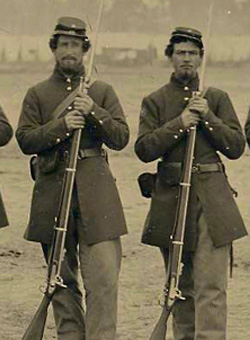
Please send all Checks and Money orders to :
Dave Taylor P.O. Box 87 Sylvania, OH 43560
419-842-1863
Click Here to E-mail Us!
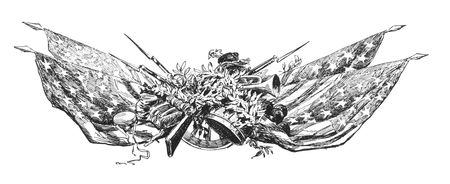
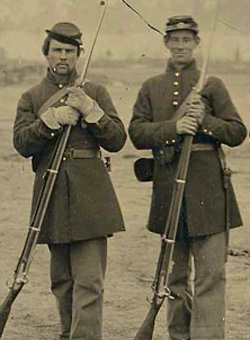
16-09-02
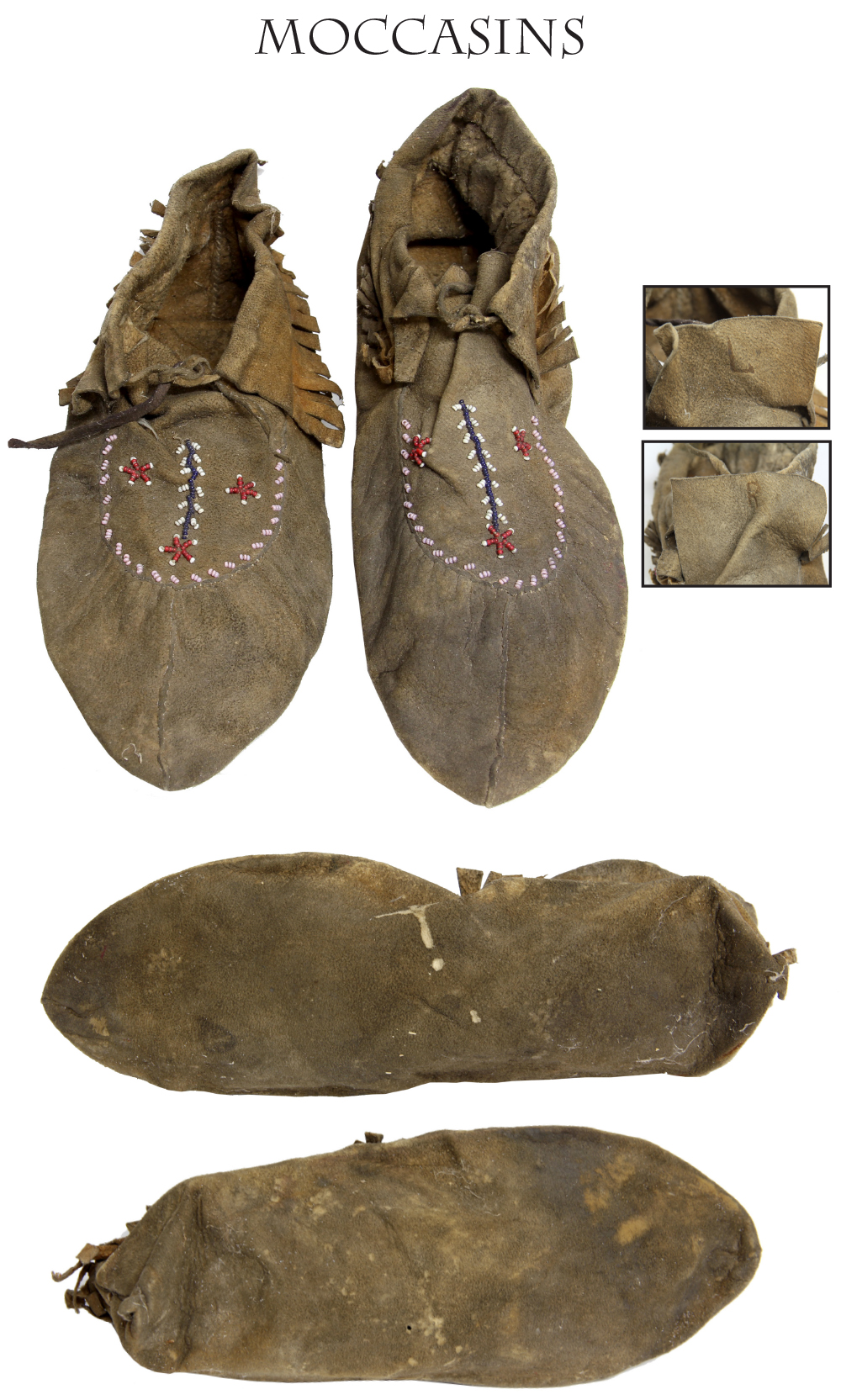
16-09-01 GENUINE ANTIQUE INDIAN MOCCASINS Northeast woodland Indian moccasins. Soft deer hide single piece moccasins with a U-shaped vamp added over the instep and typical puckered toe. Decorated in beads of white, red, brownish purple and pink. Last quarter of the nineteenth century. These are simple moccasins, more utilitarian than decorative. Whoever bought or brought them home as a souvenir apparently wore them gently. An �L� and �R� in old brown ink appear on the tongue portion of each insert. One pencil point hole in one sole. A nice pair for display showing just light use and some minor dirt and stains. Delaware, Shawnee, Iroquois, Ottawa ??? I�ll let you research that mystery. $285.00
Sold
Call us @ 419-842-1863

16-09-02 ..OFFICER OF THE DECK” US NAVY TELESCOPE…World War One naval telescope. Long brass body with single draw tube. Marked �U.S. Navy/ Officer of the Deck Spyglass / power 12 1/2/ Keuffel & Essex Co. N.Y.� with the number �2887� deeply engraved on the tube. Optics are excellent. Missing lens cap and eyepiece shutter closure. The officer of the deck functions as the representative of the Captain and has responsibility for the ship. This telescope is a venerable piece of nautical history from the days before radar and sonar, when making a visual sighting of an enemy first could mean the difference between life and death at sea. Great item. $195.00
Sold
Call us @ 419-842-1863
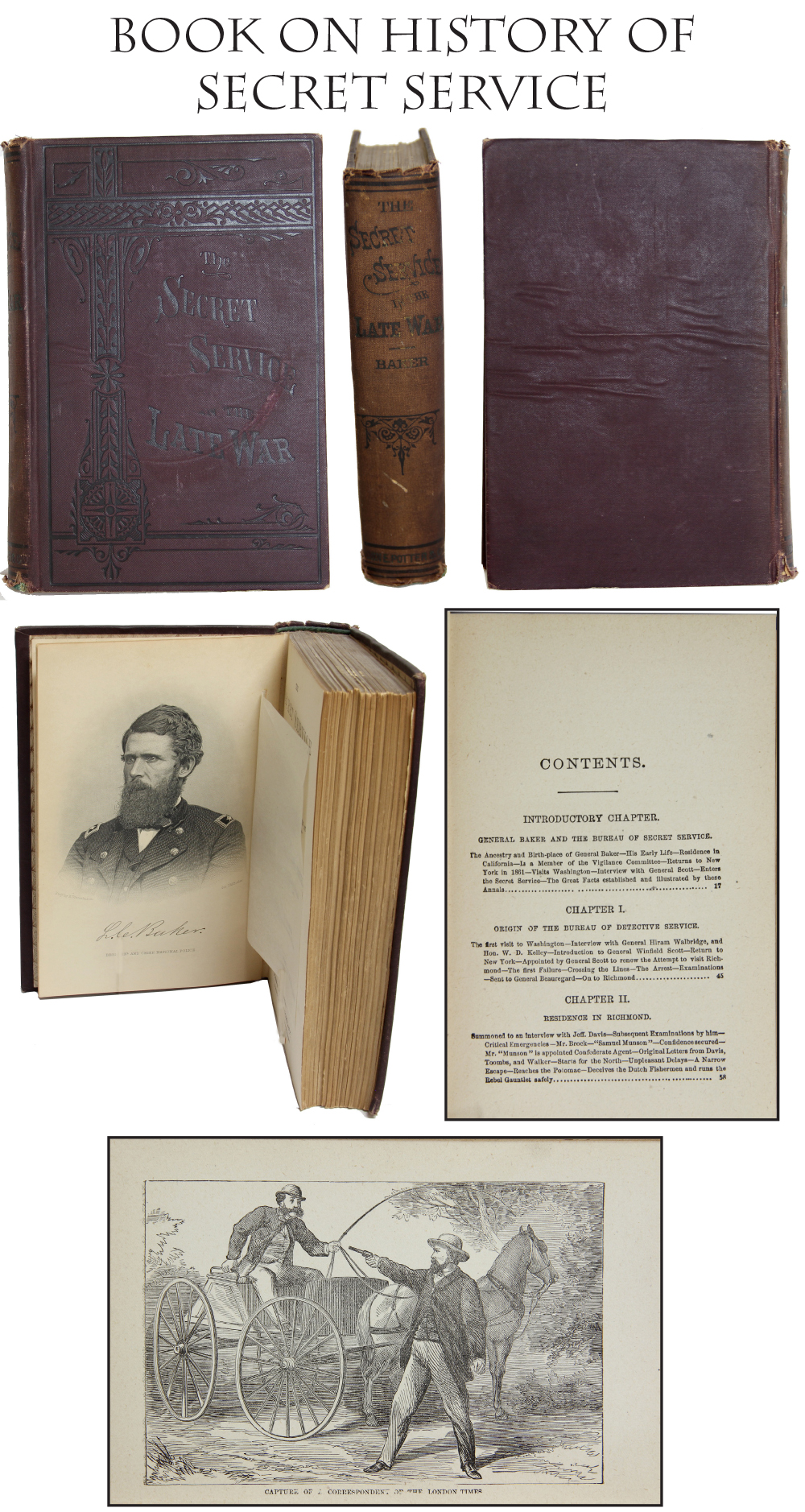
16-09-03… 1st Edition -THE SECRET SERVICE IN THE LATE WAR by Lafayette Baker… Truly excellent copy of this scarce and desirable book. Signed by owner on inner fly leaf J.E. McLelland. Published in Philadelphia: John E. Potter & Co., 1874. Orig. 19th century brown cloth binding, title & design in black, spine with title, author. 398pp + 2pp. adv. The origins and organization of the detective police. Shows only very light handling and wear. Very solid� about excellent condition. There is a copy of this book at $395.00 on biblio.com (check the link at the bottom of the description). I believe that price is ludicrous at this point in collecting history. I found a past auction on eBay with opening asking bid of $195.00 (passed). Forget the games and gimmicks�. My price� $75.00
Sold
Call us @ 419-842-1863
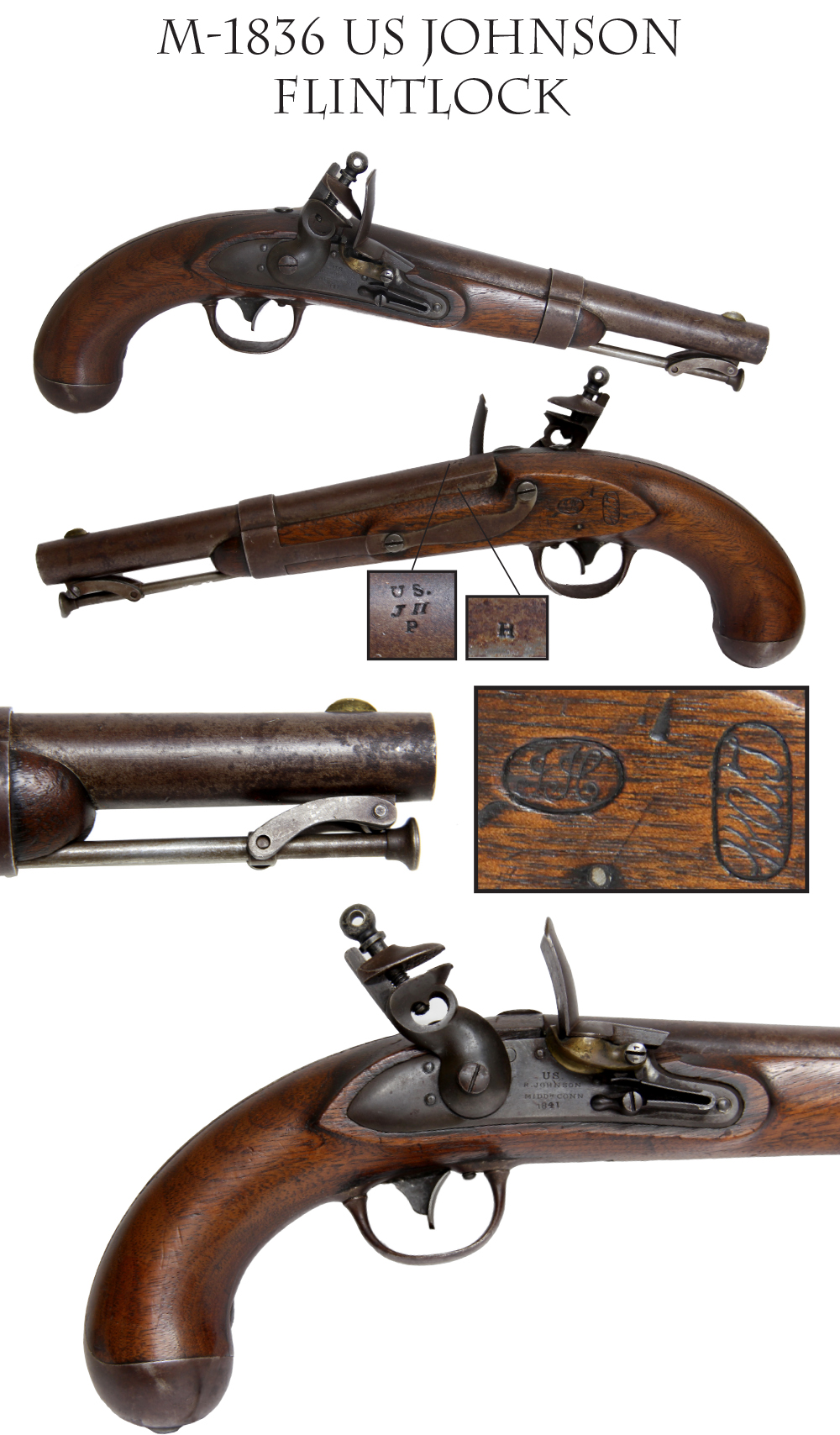
16-09-04 …EXTRA FINE M-1836 JOHNSON FLINTLOCK … A very strong example of this classic US martial pistol intended for the saddle holsters of dragoons. These .54 caliber pistols were improved versions of the 1826 pattern and were made from 1836 to 1844 by Waters and by Johnson. Ours is an 1844 dated example by Johnson with sharp US/JH/P and H barrel proofs and crisp JH and WAT cartouches in the wood on the off side. Excellent wood in warm brown tones with sharp edges. Very good muted case colors on lock and hammer. Nice untouched patina to the brass pan. Side plate and barrel show plum brown with some silver gray and dark gray spots to the barrel towards the muzzle. Front sight and loading assembly in place. Action perfect. An extra fine example of the last of the US martial flintlock pistols with a good date placing it just before the Mexican War. NRA fine to excellent condition. $1,650.00
Sold
Call us @ 419-842-1863
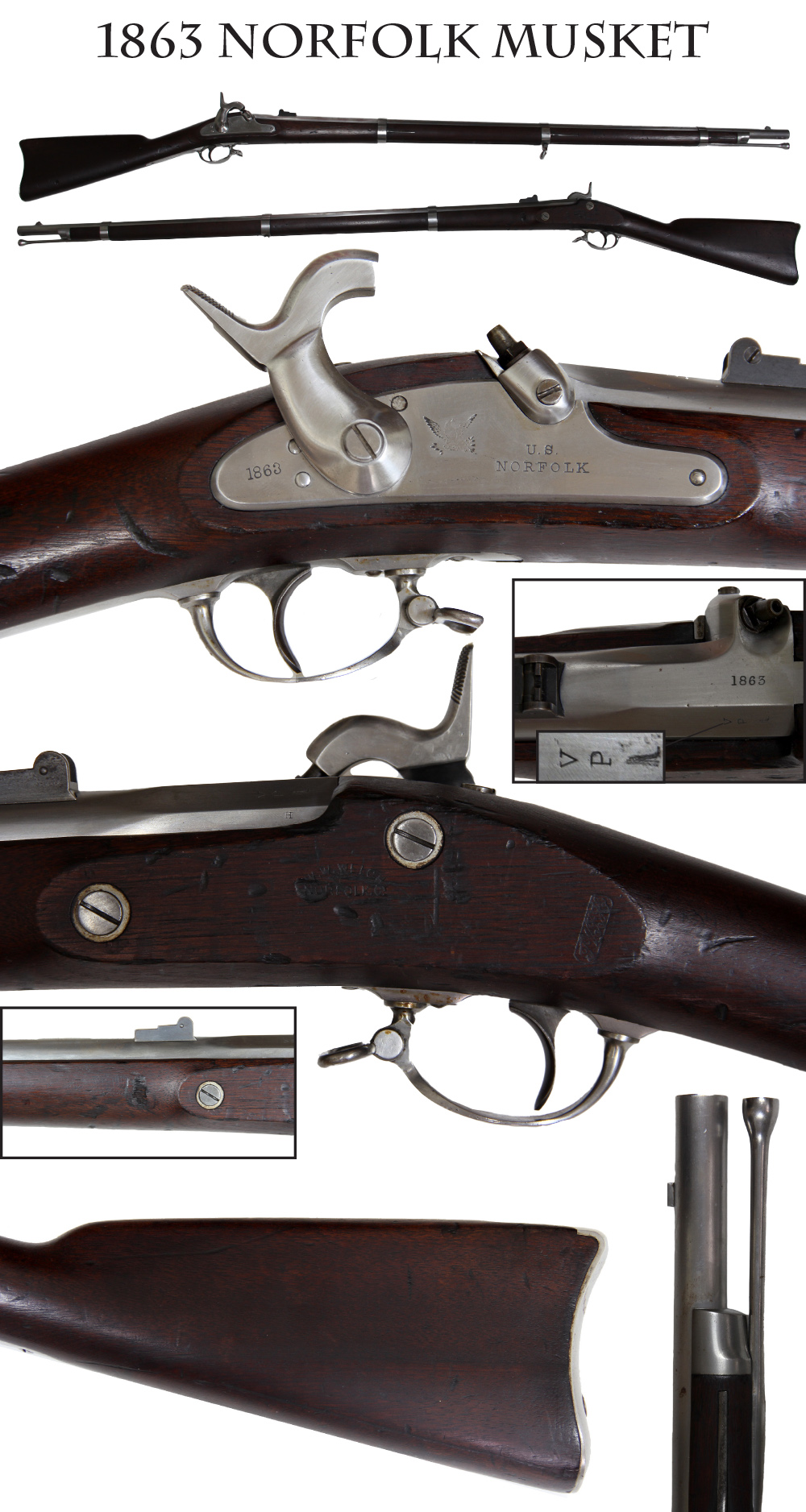
16-09-05 …EXTRA FINE CONDITION M-1861 SPRINGFIELD PATTERN CONTRACT MUSKET…
Welch, Brown and Company of Norfolk, Connecticut, manufactured only about 18,000 of these 1861 pattern rifle muskets in 1862-1863. This one is NRA fine+ condition and shows off well �in the bright�. Markings and dates are crisp on the lock, breech of the barrel and the side flats as well. The eagle on the lock is slightly light from the original strike. The metal is smooth and bright. The rear sight retains a ton of original faded blue. Not only that, the maker�s and inspectors� cartouches on the side flat of the stock are deep and legible. The wood does show some dings from handling and storage at the wrist and side flat, and there is a small, shallow, thumbprint size gouge on the left just below the rear sight, forward of the side flat. The stock edges are very sharp. All in all this is a very showy gun with all bands, springs, swivels, rod and sights in place, and mechanically excellent. A top shelf example of the classic Civil War infantryman�s rifle musket. You will be hard pressed to find another in this condition at this price. $2,750.00
Call us @ 419-842-1863
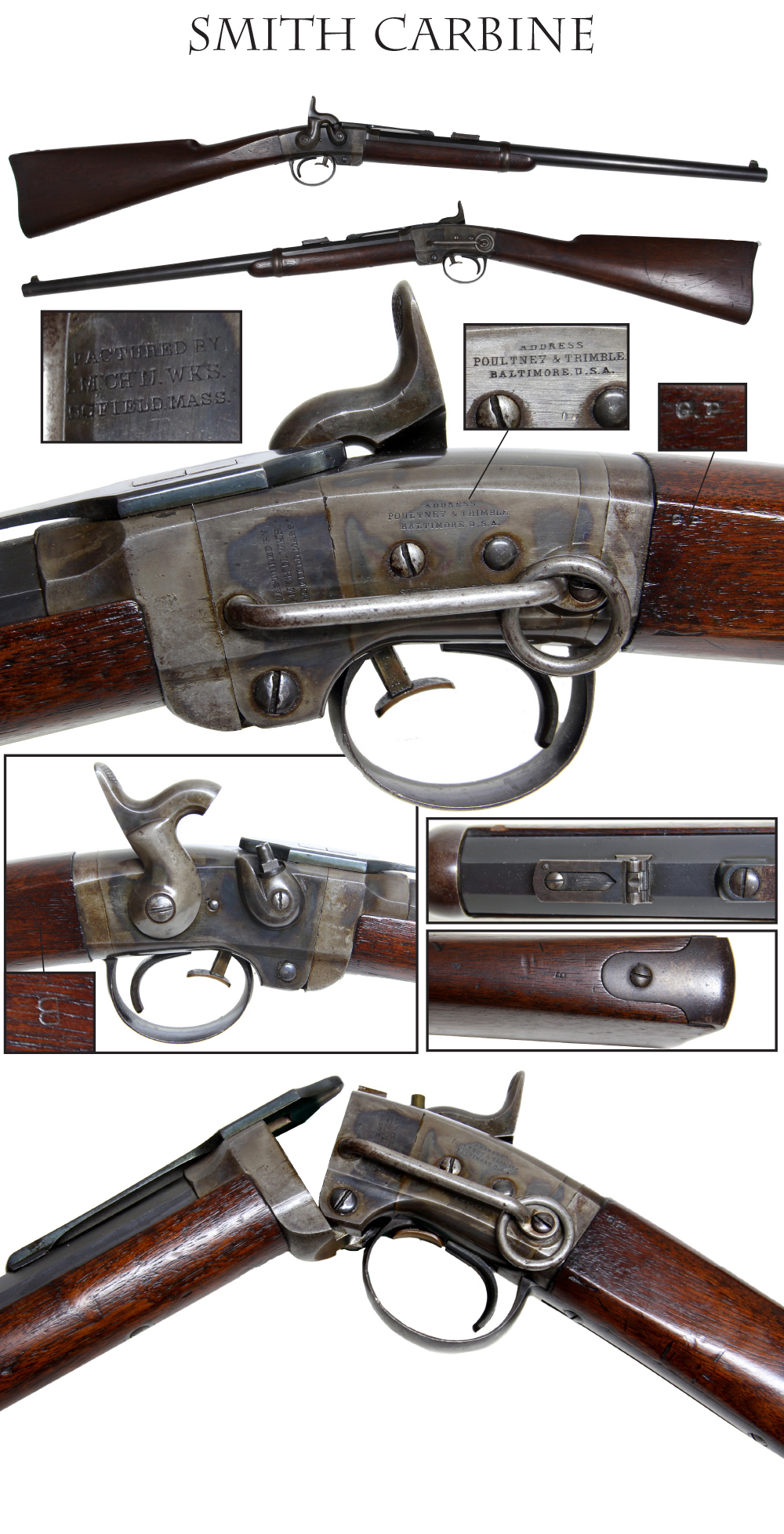
16-09-06 … NEAR MINT CONDITION SMITH CARBINE … This is the carbine you put at eye-level in the gun rack. Top notch condition Smith rating an NRA Excellent to near mint condition grade. Barrel and band loaded with blue, sharp edges to the wood, with crisp inspector, sub-inspector and assembly cartouches. Iridescent blue on the top bar. Vivid “oil on water” case colors floating on the receiver. Tight wood to metal fit and locks up tight. Poultney and Trimble agent stamp on the left frame along with the marking of the American Machine Works, one of three contractors making the Smith. Side bar and sling ring in place. A few light scratches on the butt flats and a pressure ding or two. Mint bore. 100% original, 100% complete, mechanically perfect. A very nice carbine, used by the 1st Mass. Cavalry, 7th Illinois, 17th Pennsylvania and many other cavalry outfits. My friends and competitors in New York, New Jersey, and Pennsylvania would price this gun at over three grand… friendly Ohio price… $2,450.00 Sold
Call us @ 419-842-1863
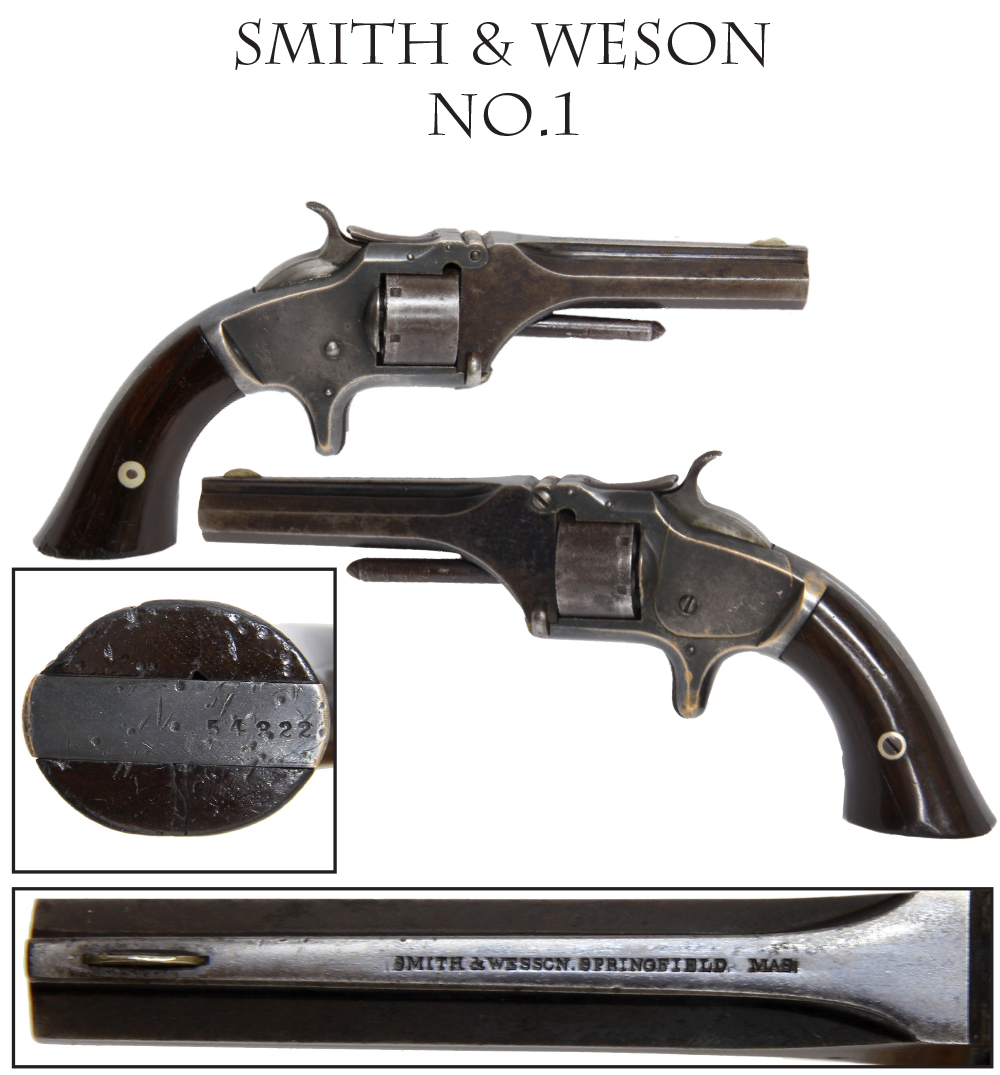
16-09-07 …EXTRA FINE SMITH & WESSON No. 1… These 7-shot .22 caliber pistols were popular sidearms and were made by the company from 1860 to 1868, introducing Americans to self contained rimfire metallic cartridges. Ours is the “No. 1 Second Issue” characterized by the flat frame and irregular side plate. Numbered from 11672 up to 128,000, ours is number 54,322, falling a little earlier than halfway through the production. These show up with Civil War inscriptions with enough frequency to show that officers and some enlisted men considered them a good sidearm. I have one in my collection inscribed to the Chaplain of the 10th Michigan which I got from long time Michigan collector Doc Singelyn up in Grosse Pointe a few years ago. This one is mechanically perfect and locks up well. There are generous amounts of blue on the top rib and a crisp maker’s stamp. Good wood to metal fit and very nice grips, just some dings to the bottom of the butt. Most of the silver plating remains on the brass frame and has tarnished to a magnificent bluish pewter patina. Stunningly attractive and untouched. Melds with the blue beautifully. A nice officer’s sidearm, soldier’s pocket pistol, and western traveler’s vest gun. Fine++ condition … $465
Sold
Call us @ 419-842-1863

16-09-08 … CONN. ARMS CO. PISTOL … Quite a number of arms makers tried to get around Rollin White’s patent of the bored-through cylinder. The Connecticut Arms Company tried it with their .28 caliber six-shot revolver firing a cup-primed cartridge and using a hook ejector on the lower right side of the frame. Only about 2,700 of these were made in the mid-1860s, so it is a fairly scarce little gun. Most of the silver finish is gone from the brass frame, some remains in the recesses. The grips are good and tight to the metal.The barrel assembly, cylinder, and hammer show gray with darker gray areas. The top flat has a crisp maker stamp, and the patent marking is visible on the cylinder. Half and full Cock are fine, but cylinder stop does not function. I’ll let you monkey with it. Flayderman says the knob on the arm of the hook extractor is a scarce, late variant. This must be among the first to receive the knob ejector as it bears the early single line patent stamp on the cylinder with date of 1864. It is not the two-line marking dated 1866 which Flayderman associates with this style of ejector. An interesting American pocket revolver of the Civil War and early American west. I do not recall owning one of these previously. A neat little revolver that fits in the palm of your hand, $465.00
Sold
Call us @ 419-842-1863

16-09-09 …AUSTRIAN LORENZ RIFLE … The .54 Austrian Lorenz rifle was imported by both sides in large numbers. Perfect for dispay with US or CS weapons. Carried by thousands of rebels from Tennessee as well as Iron Brigade boys from Wisconsin. Ours has the usual Austrian maker and arsenal marks on the barrel and the proper three digit “857” lock mark indicating manufacture in 1857. Medium to dark brown tone to the wood stock, which shows a minor repair at the right wrist next to the barrel tang and behind the hammer where a piece of wood broke out and was put back in place, which is not an uncommon thing with Lorenz rifles. Mechanically fine, the metal overall is gun metal gray with a slightly brighter bolster. The hammer and lock somewhat darker, showing some mottling in patina. Some rounding to the wood edges, all bands and swivels in place. Rear folding ladder sight. Correct rod. A large set of initials “C.C.B” carved on the raised cheek piece of the left flat, which is a nice bit of soldier’s personalization, though not enough to go on to identify the carver. A widely used longarm by both sides in all theatres of the war. $1,250.00
Sold
Call us @ 419-842-1863
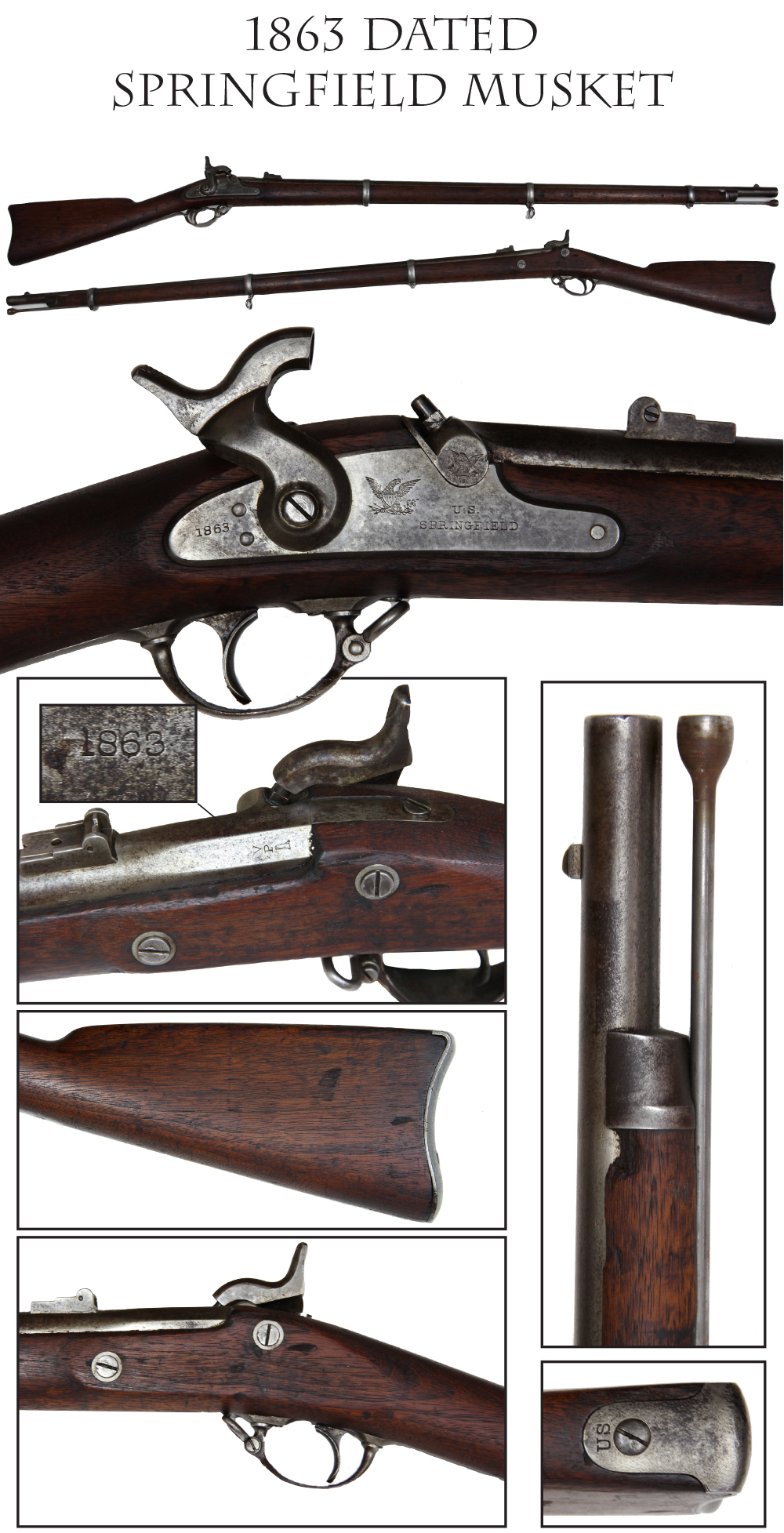
16-09-10 … 1863 DATED SPRINGFIELD RIFLE MUSKET … This is the true 1863 Springfield, manufactured for only one year at most, using the beveled S-shaped hammer popularized by Colt in their “special model” rifle muskets, and utilizing Colt clamping style barrel bands with no band springs in the stock. The first element was successful. The band retaining springs however, turned out to be absolutely necessary and were reintroduced for the 1864 pattern. Nice, crisp maker mark, date, and Springfield eagle on the lock plate and an equally crisp eagle on the bolster. Mechanically excellent. Both sights, all bands and swivels in place. Ram rod is a correct modern made replacement. All other elements are original. Sharp matching 1863 barrel date and V/P/eagle proofs on the side flat. Metal is silver gray overall, smooth, with darker gray mixed in. A very light bit of salt and peppering just at the muzzle from actual firing. Lock and hammer are mostly gray. Wood has a nice warm brown tone. Some handling dings and divots. Small piece out of forestock near the nose cap. One horribly faint oval cartouche is barely discernable on the left flat opposite the lock. Some faded blue on the rear sight. Bore is hideous. A nice mid-war rifle musket with good date. $925.00 Sold
Call us @ 419-842-1863
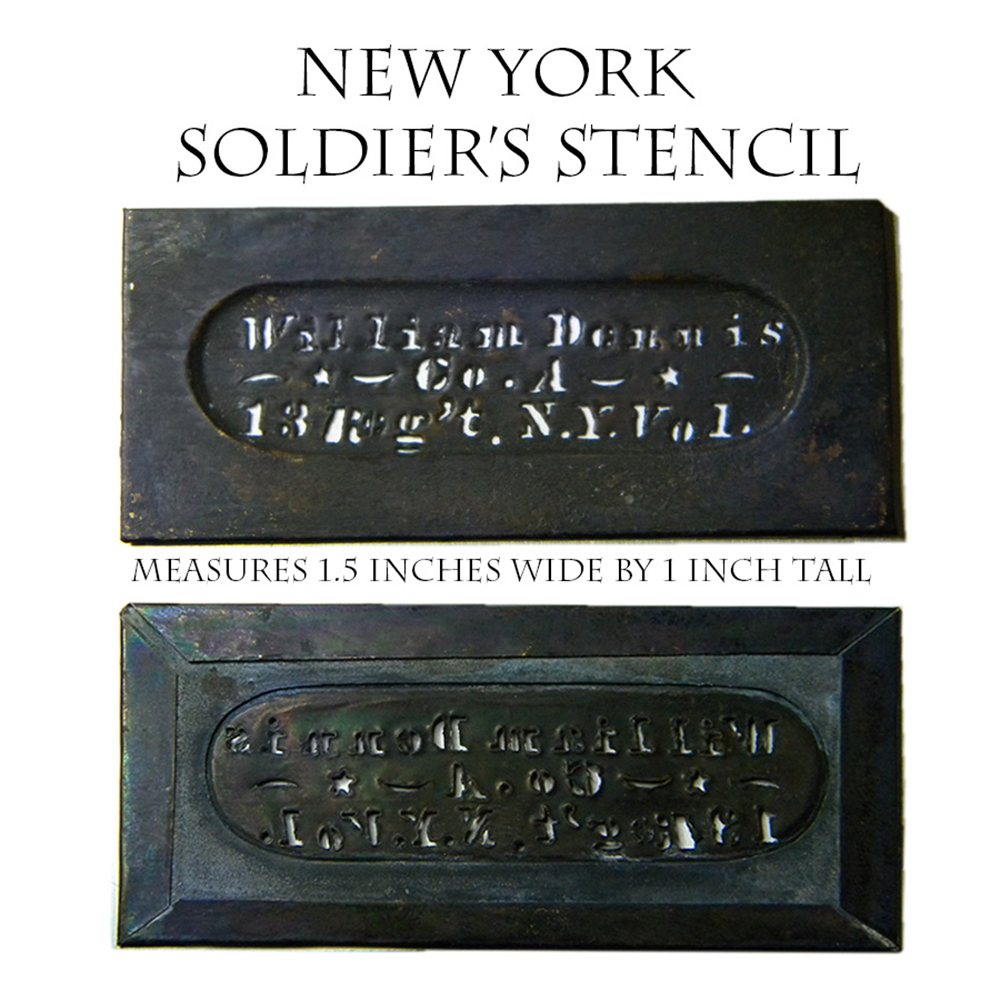
16-09-11 … NEW YORK SOLDIER’S STENCIL … One of the handy devices marketed to new recruits was a stencil and ink kit for marking their gear. This one measures about 1.5 by 1 inch, is a standard brass sheet folded over a white metal frame, made for, �William Dennis / Co. A / 13 Reg�t. N.Y. Vol.� Like many commercially made stencils and ID discs, this one presents a research challenge. We don�t find a William Dennis in Co. A of the 13th NY. Infantry Vols. We find a William Dennis in the 13th NY Heavy Artillery, but he served in Company K not A. His record shows on 7/1/1864 he mustered into “K” Co. NY 13th Heavy Artillery He was Mustered Out on 6/28/1865 at Norfolk, VA. Researching further we find a more likely candidate, who is in the precise company and regiment as shown on the stencil. He is William H. Denning of Co. A of the 13th New York Infantry, known also as the Rochester Regiment. Denning enlisted at age 23 in Rochester, NY, on 4/25/61 and mustered into Co. A as a private on 5/14/61. The regiment was one of the very early New York regiments and its first enlistment in the US service was for three months, which was then extended to two years to bring it into line with other early war NY regiments. It saw action at First Bull Run, where it lost 58 men. It then spent some time doing guard duty in Georgetown, but was again in the field for McClellan�s peninsular campaign, where it served in the Fifth Corps. At the very beginning of the Seven Days Battles it was caught up in the heavy fighting at Gaines Mill, where Denning was killed in action on 6/27/62. This item belonged to one of the two above listed men� most likely the KIA soldier. $375.00
Sold
Call us @ 419-842-1863

16-09-12 …EXCEEDINGLY RARE 1864 DATED TOWER ENFIELD … A very rare date for an Enfield! I can only think of only two that I have owned in forty-some years. By that point in the war the US arms makers had caught up with demand, the Federal government was not purchasing any more of them, and the blockade had cut Confederate imports to a trickle. In my opinion the 1864 dated guns were all intended for the south, and very few made it. This one obviously did make it through, and shows some slight rounding to the edges of the wood indicating it was actually issued and used. Crisp crown, 1864, and Tower markings on the lockplate, as well as the �25-25� barrel stamps at the left breech. All bands, swivels, the correct rod, and the front and the rear long-range folding sight are present. Barrel is smooth metal showing significant stretches of faded blue mixed with pewter gray, as does the rear sight. The bore and mechanics are good. The hammer shows some muted case colors. The bolster shows some mild salt-and-pepper firing corrosion. The lock shows more a silver gray and brown with some very faint pewter tones that are the remnant of case. The wood is a pleasing, uniform, dark tone overall, with some small dings and scratches and some wear to the edges of the butt. There is a hairline shrinkage gap along the back and upper edge of the plate. A very tough to find example of an almost certainly Confederate late-war long arm. When was the last time you saw an 1864 dated Enfield??? $1,595.00 Sold
Call us @ 419-842-1863

16-09-13 …CIVIL WAR REGULATION HAVERSACK WITH THE ORIGINAL RICE BAG … The haversack was one of the soldier�s essential pieces of gear, second only to his canteen. This is the regulation 1851 pattern of tarred canvas, complete with its separate interior �rice bag,� that was meant to keep the food from coming into contact with the body of the bag itself. Most of these fell victim to the need for gun rags, etc. Veteran�s recalled fondly reaching into the greasy depths of the bag at the end of a long march to food they would have rejected in civilian life, but came to regard as a feast on campaign. They were constantly on the lookout for haversacks dropped or left unguarded by the lazy or inexperienced on a long march. As essential and numerous as these bags were during the war, they have always been scarce to collectors. They were elusive in the 1960s and only one in fifty that survive today still retain the rice bag. That little element is really rare. They were so useful after the war for general purposes, schoolboy book bags, etc., that they were quickly used up and thrown away when worn out.v Even when Bannerman had stacks of knapsacks piled to the ceiling, haversacks were uncommon. I have not seen an original CW haversack this nice on the market in a long time. Shoulder strap in place and secure with no breaks, tears or mends. Buckle and closing strap in place and secure. Bag intact with no holes or tears. Rice bag in place inside, buttoned in place with three tin buttons. The shoulder strap has some lengthwise folds and there are a couple of spots on the bag where a piece of newspaper that it was stored in adhered to the bag, but these are very small. I can’t praise this one enough. $1,950.00
Sold
Call us @ 419-842-1863
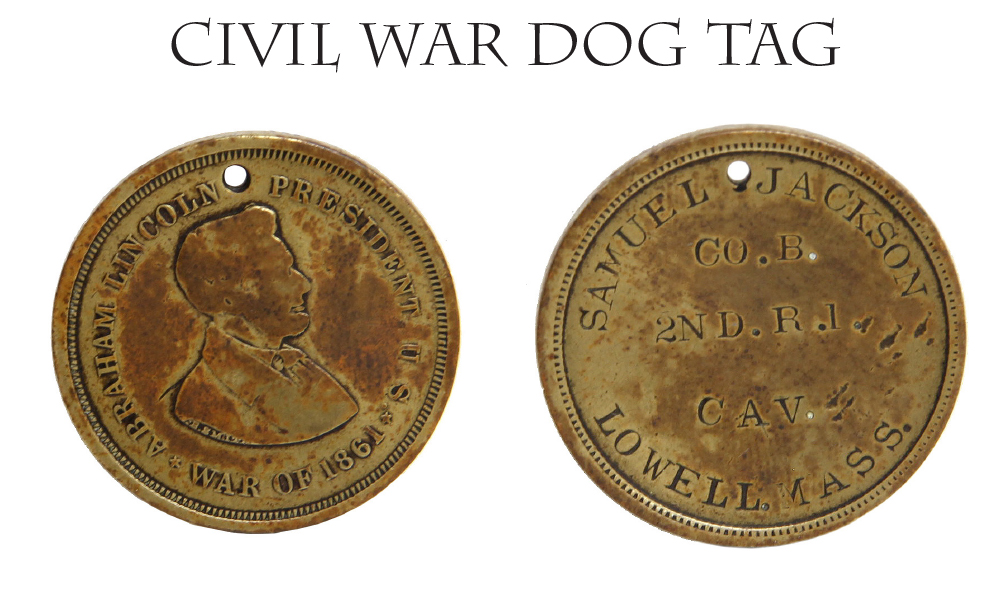
16-09-14 …FROM GENERAL BANKS� BODYGUARD TO MUTINEERS: SECOND RHODE ISLAND CAVALRY IDENTIFICATION DISC … Another wonderfully personal relic of the war, the identification disc of Samuel Jackson, Co. B, 2nd R.I. Cavalry. This is a Lincoln bust pattern ID disc with �Abraham Lincoln President� and �War of 1861� surrounding Lincoln�s profile bust on one side and the soldier�s name and unit information stamped on the other by the sutler or peddler. In this case, Jackson also had his hometown of Lowell, Mass. added on the bottom of the tag as well. He enlisted on 11/10/62. He mustered into Co. B of the 2nd RI on 12/1/62. The unit was conceived of as a regiment, but never reached more than two battalions in strength. They were sent to join Gen. Banks in Louisiana in early 1863 and Company B was detailed as Banks� bodyguard for a short time after they arrived in mid-March. Dyer summarizes their service as follows: Ordered to New Orleans, La., and served duty there until March 1863. Moved to Baton Rouge, Louisiana, March 6-7, 1863. Participated in the operations against Port Hudson March 7-27. Moved to Algiers, then to Berwick April 1-9. Operations in western Louisiana April 9-May 14. Teche Campaign April 11-20. Franklin April 14. Near Washington May 1. Expedition from Opelousas to Alexandria and Simsport May 5-18. Operations about Monett’s Plantation and on Bayou Sara Road May 18-19. Moved to Bayou Sara, then to Port Hudson May 22-25. Siege of Port Hudson May 25-July 9. Jackson Cross Roads June 20. Springfield Landing July 2. Surrender of Port Hudson July 9. Much of this service involved small unit actions, foraging, scouting, and patrol duties. CWData shows 19 data points during that period when the regiment suffered losses of one sort or another. A critical part of their history took place in August and September of 1863. They had been reduced in strength from their active service and were ordered consolidated into a battalion and transferred to the 1st Louisiana Cavalry. Discipline and morale were at a low ebb and the men regarded the transfer as a violation of the terms of their enlistment, refused to follow orders and mutinied. Lt. Col. Harai Robinson of the 1st Louisiana suppressed the outbreak by arresting and immediately executing two of the regiment by firing squad. In an ironic ending to the whole affair, the remnants of the regiment were later transferred out of the Louisiana unit and into the 3rd Rhode Island Cavalry, which, had it been done to begin with, probably would have prevented the whole tragedy. Samuel Jackson was on the rolls of the unit at the time. His service record shows a transfer to Co. H of the 1st Louisiana as of 8/24/63 and then to the 3rd RI Cavalry on 1/14/63. The date and method of his discharge from that unit are unstated, but he likely had had enough of army life long before. The tag shows wear to the high points of the Lincoln bust but a crisp stamping of Jackson�s name and unit information. Lots of history and a rare disc. $850.00
Sold
Call us @ 419-842-1863
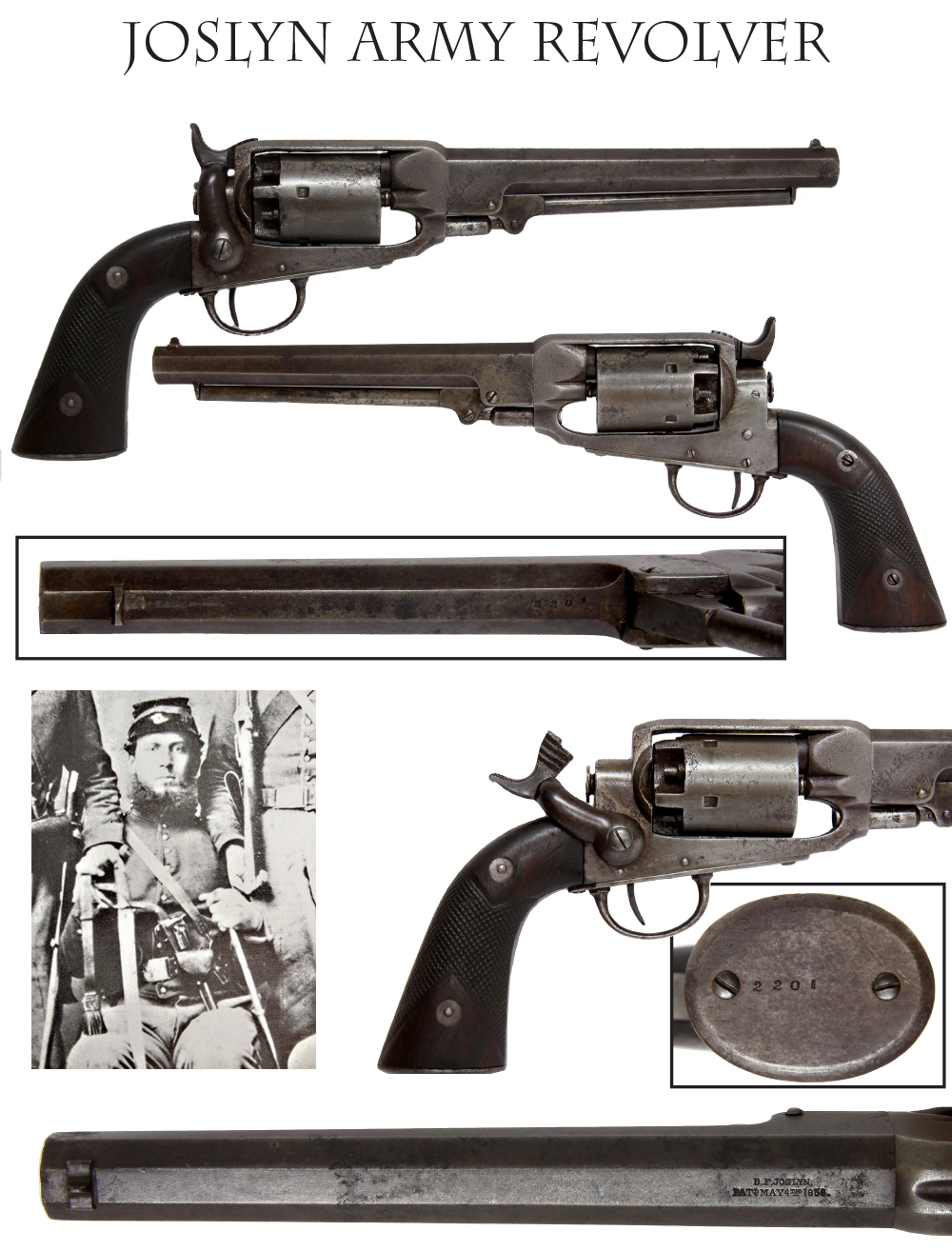
16-09-15 …JOSLYN ARMY REVOLVER… Only about 3,000 of these revolvers were made by B.F. Joslyn in 1861 and 1862. A very few were purchased by the US Navy, 1,100 were purchased on the open market, about all of which went to Ohio, with a lot going to the 5th and 6th Ohio Cavalry. Others went to various Illinois, Kansas, Indiana and Minnesota units. The pistol is characterized by its solid frame, which offered some robustness, and a side mounted hammer that may have made it easier to repair. Like the Colt and Remington armies, it is .44 caliber, but carries only five shots. Ours preserves its original checkered grips in great shape, and shows hints of its original blued finish in different areas. Overall the metal is smooth and silver gray, with just a small amount of percussion-cap peppering around the back of the cylinder from firing. Clear Joslyn maker and patent stamp on the rear of the upper barrel flat and matching serial number 2201 under the barrel and on the butt cap. The hammer shows muted case color and the screw heads even have some traces of blue. A very nice example of a scarce cavalry side arm that saw lots of action out west. A very scarce Civil War cavalry weapon in solid condition. $3,250.00
Sold
Call us @ 419-842-1863

16-09-17 9th NEW HAMPSHIRE PRISONER OF WAR IDENTIFICATION DISC Civil War �Eagle / War of 1861� identification disk belonging to Edmond Gallup, Co. E 9th New Hampshire Infantry. There is nothing more personal than a soldier�s dog tag. They were not items of issue, but purchased to wear in times of danger so that he might be identified if killed in battle and his relatives notified of his fate. One soldier joked they were to identify them if �lost, strayed, stolen or killed,� but it was serious matter. None wanted to vanish into the large realm of the missing, whose fate was uncertain to fellow soldiers and loved ones. Edmund W. Gallup was living on a farm with his parents and several sisters when he enlisted in Plainfield, New Hampshire at just 19 years of age on Aug. 4, 1862. He mustered into Co. E of the 9th New Hampshire on August 8, 1862, for three years of service. As part of the 9th Army Corps, the regiment saw action at South Mountain, Antietam and Fredericksburg, before heading west in the Spring of 1863, to take part in the Vicksburg Campaign and other movements. It returned east in time for Grant�s overland campaign in 1864 and saw heavy action, particularly in the ferocious fighting at Spottsylvania on May 12, 1864. Gallup must have been a decent soldier. He was made a corporal at some point in his service. Fate caught up with him, however, in the Petersburg Campaign. He was one of several members of the regiment captured at Poplar Springs Church. George Wakefield, a sergeant in the regiment, summarized the action as follows: August 19 the Ninth Corps was sent to the Weldon Railroad. Here it assisted the Fifth Corps in repulsing a determined advance of Confederates on August 20 and 21. Up to September 30 the corps were engaged in picket duty, building works, and making corduroy roads. On that day the Fifth Corps drove the enemy from their outworks at Poplar Springs Church; the Ninth Corps then advanced, came up with the enemy, and the Ninth New Hampshire, with its brigade, was ordered to charge. The Confederates again gave way; the impetuous Ninth New Hampshire followed, but encountering superior numbers was flanked and forced back, contesting every inch of the ground, to Pegram House, where the advance of the enemy was checked. It is not clear how long Gallup spent in enemy hands. We know that he was back in Union lines by the beginning of the new year. Whether he escaped from captivity or was paroled is unknown, but he is recorded as dying of disease at Petersburg on January 15, 1865. It must have been a hard blow to his family to lose him after such long service and so close to the end of the war. His service and pension records will certainly add to the story: his mother applied for a pension in August, 1865. A very touching memento. $850.00
Sold
Call us @ 419-842-1863

16-09-18 … INCREDIBLY EFFECTIVE LIGHTED MAGNIFYING GLASS / PERFECT FOR INSPECTING ANTIQUES … You have undoubtedly seen collectors at the shows running around with one of these magnifying glasses in their hand. There’s a good reason … they are SUPER! Months ago I bought one for myself and loved it. Then the local guys wanted one and I bought another half dozen for them at $25 each at the next show … Then I bought another one for me when I arrived at a show and discovered I’d left mine at home. I figured with as many as I was buying at retail, I might as well buy them in bulk and sell them at the shows and on the web page. These are absolutely essential for anyone buying antiques at shows or auctions. The intense illumination from the twelve LED light sources and 2x magnification exposes “artificial age” such as cold-blue on metal or amber shellac on wood. Shine this light and you will see if someone has “aged” or repaired the item you wish to buy. The magnification accompanied by the intense illumination reveals cracks and repairs that the naked eye cannot pick up. Requires 3 AA batteries (not included) … $25.00
Call us @ 419-842-1863
Layaways are Welcome
Need to split your order into multiple payments? No problem! A simple 20% earnest money deposit will hold your item for you.-acf
You can then pay it off in easy installments that fit your budget.
Read Terms Here
Items to Sell? Contact Us
I am always interested in buying ANYTHING from the American Civil War… Guns, Swords, Civil War Muskets, Knives, Uniforms, Flags, Medals, Badges, Diaries, Letters, Autographs, Buttons, photographs, tintypes, daguerreotypes, Insignia, Camp Items, Battlefield Relics, canteens, Drums, Etc… Call 419-842-1863 and ask for Dave Taylor.

